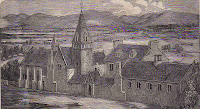The Story of Weaving in Crieff & Strathearn ( Part One )
If it wasna for the weavers , what would you do ?
Ye wouldna hae your cloth that’s made o woo
Ye wouldna hae your cloak neither black nor blue
If it wasna for the wark o the weavers !
The pictures in descending order are 1. College Buildings Crieff where some 50 weaving families lived 2. Diagrammatic sketch of 62/64 Burrell Street Crieff , once weavers' houses 3. A weaver at his hand loom and 4. "Weavers window " - built to allow light into the attic space .
********************************************************************************************
Linen had been a major industry in Scotland for hundreds of years; by 1684 an estimated 12,000 people were employed its manufacture. The industry was stimulated by an Act of Parliament of 1686 stipulating that everyone had to be buried in linen winding sheets made from materials which had been grown, spun and woven in Scotland. Further stimulus came from the Act of 1748 prohibiting the importing or wearing of French cambrics, "under severe penalties"; and that of 1751 which allowed weavers to work in all parts of Scotland "free of all corporation dues, conjoined with a bounty of 1 1/2 d. [0.6 pence] per yard on all linens exported at and under 18d [7.5 pence] per yard." Linen had by this time become Scotland's most important export. Although superseded by the cotton industry, in 1838, there were still 17,900 linen factory workers, which had grown to 31,700 by 1856 . There appears to have been substantial consolidation in the industry then however, for the number of factories decreased between 1838 and 1856 from 183 to 163 presumably as a scale effect of the economics of increased mechanisation.
Before the American War of Independence, the tobacco trade had been a major source of wealth in Scotland (contributing largely to Glasgow's growth). Subsequently the Americans could sell freely anywhere, resulting in a substantial decrease in Scotland's trade. This resulted in investment being diverted into cotton, and this industry dominated Scotland's economy for the next hundred years. But the influence of America on Scotland was felt again in the 1860s, when the Civil War cut off supplies of raw cotton and Scotland's cotton industry collapsed. This began Scotland's shift from textiles to heavy industry.
In 1838, an estimated 85,000 hand-looms were in use in Scotland: about 50,000 for cottons, in Lanarkshire and Renfrewshire, and about 26,000 for linens, mainly in Fife and Forfarshire ( Angus ). Dunfermline was the centre of "harness" work, such as damask table cloths, napkins, with about 3,000 looms. "Ordinary" linen work - sheets and coarse linens ("dowlas and "osnaburghs") was the staple manufacture, located mainly in Forfarshire (around Dundee). This work employed from 17,000 weavers in summer, to 22,000 or 23,000 in winter, nearly all in small detached buildings adjacent the weavers' cottages. The weaving of tartans - employing about 2,500 looms - was concentrated mainly at Stirling and Aberdeen, was done in the weavers' cottages. But Glasgow had been renowned for its plaids in the early 18th century.
Wages paid to weavers in Scotland, the North of Ireland and England declined by between one-half to two-thirds between 1815 and 1835, resulting in widespread and severe suffering and distress. Although the price of food fell in the same period, it did not match the fall in wages, falling about 30 %. Many weavers resorted to theft of weaving materials.
The reasons for the decline in wages were the increased use of steam machinery, heavy taxation necessitated by the war, the fluctuations in the amount of money in supply, the competition from foreign manufacturers, and the over-supply of cloth caused by the need to work long hours to earn a basic subsistence. The effect of the introduction of the power-loom was aggravated by the general fall in the price of agricultural products and by contraction of the currency. The foreign competition was to a large extent fuelled by the export of British yarn.
Part Two will look at weaving in Crieff and Strathearn. The effect of the destruction of the early factories by the Government / Hanoverian troops in 1746 after the Jacobite uprising and its subsequent revival into a business where some 60 % of the town's work force were involved directly or indirectly .






.jpg)
Thanks for Sharing this wonderful information, read more
ReplyDelete